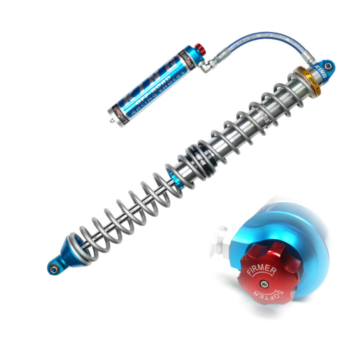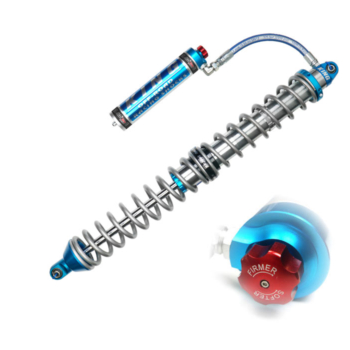How King Compression Adjusters Work
King Shocks offers Compression Adjusters on their 2.0, 2.5, and 3.0 coilovers, smoothies, and internal bypass shocks. These adjusters feature a single knob that allows for quick adjustments to mid-speed compression, giving you the ability to fine-tune ride comfort and performance. Not only do they help you achieve the ideal ride, but they also enhance the shock’s functionality and can save you countless hours of suspension tuning. Compression adjusters increase damping force and require specialized tuning. At AccuTune Off-Road, we custom-tune your shocks to ensure they operate within the optimal range of adjustment for your needs.
How Does The King Compression Adjuster Work
The King compression adjuster features three flow paths: a large adjustable through-bleed, a high-speed non-adjustable disk stack, and a rebound check valve. By incorporating a large-diameter free bleed with an adjustable orifice, King has adapted a design typically used for low-speed compression adjustment into one suited for mid-speed compression tuning. This results in a simple-to-use adjuster that primarily affects mid-speed compression. We’ve found that the most effective range for this adjuster is typically more than 4 clicks open. Below 4 clicks, the adjuster begins to act more like a low-speed adjuster, but with significant adjustments between clicks, which can lead to a rapid shift from comfortable to harsh.
As you turn the knob on the King Compression Adjuster, the size of the flow path changes, either increasing or decreasing. The unique design of the adjuster is intended to ensure each click provides a consistent amount of adjustment. Compared to the Low Speed Fox adjustment, the flow volume on the King adjuster is significantly larger. This increased volume is what enables it to effectively function as a mid-speed adjuster.
How Much Adjustment Does The King Compression Adjuster Have
The downside of the high-flow, mid-speed compression adjuster design is that it doesn’t significantly impact the damping curve in ways that are most useful for specific performance needs. To fine-tune road feel, handling, and g-outs, we typically want to adjust low-speed damping. For controlling performance on big bumps or whoops, high-speed adjustment is key. While the mid-speed adjuster does affect both of these aspects with a single knob, the level of adjustment is not as precise or as substantial as it would be with separate low- and high-speed adjustments.
Mid Speed Adjuster Design Impacts Low & High Speed, Just Not Very Significantly
At low speeds, the King compression adjuster can add up to 60% more damping across its entire adjustment range. However, nearly all of the low-speed damping adjustment occurs within the first four clicks, making it difficult to control and less effective for fine-tuning. If your adjusters are open four clicks or less and it’s not harsh, it’s a sign that re-tuning is necessary. Due to the limited adjustment and the rapid, uncontrollable changes within this range, the King Compression Adjusters don’t provide useful low-speed compression adjustment. While King doesn’t advertise their adjuster as a low-speed compression solution, it’s important to note its limitations in this area.
At high speeds, the King compression adjusters can add between 25% (on solid axle and standard IFS vehicles) and 40% (on light IFS vehicles) more damping, depending on the type of vehicle. High-speed adjustment is applied in manageable increments across the last 24 clicks. The adjuster is particularly effective on IFS vehicles, as they operate at slower speeds, where the mid-speed adjuster proves more beneficial. The downside, however, is that IFS shocks operate at higher loads, making the range of adjustment a smaller percentage of the overall damping.
Other Benefits of Compression Adjusters:
Compression adjusters offer several lesser-known benefits that significantly improve the performance of your shocks, such as increased damping, better cooling, and more consistent performance.
Essentially, compression adjusters act as a second damping piston that works off the displacement of the piston rod, controlling oil flow into the reservoir. By adding this second piston, both the damping area and the damping force are automatically increased. This is especially important for 2.0 shocks on solid axles and 2.5 shocks on IFS vehicles, which may otherwise run out of damping force. Because the compression adjuster piston is positioned near the reservoir, it helps transfer heat into the oil, where it can be more effectively cooled.
Moreover, the compression adjuster piston greatly reduces the likelihood of shock cavitation, which can lead to a loss of damping. While small amounts of oil can flow easily into the reservoir, compression adjusters generally don’t allow large volumes of oil to flow freely. This forces the oil to pass through the main piston, ensuring it performs its job effectively.
These benefits alone often make adding a compression adjuster to your shocks well worth considering.
Summary
The simple design of the King Compression Adjuster makes them incredibly easy to use, but their adjustment range isn’t as extensive as dedicated high-speed and low-speed adjusters. If King Compression Adjusters align with your needs, AccuTune Off-Road can help place you in the optimal adjustment range and fine-tune the ride you’re looking for.
While King Compression Adjusters are user-friendly and provide several benefits beyond just damping adjustment, their limited high-speed adjustment range requires special valving to maximize their effectiveness. This is best achieved using AccuTune’s custom equations. With AccuTune valving and King shocks equipped with compression adjusters, you can dial in the perfect ride for your vehicle.
Related King Shocks With Compression Adjuster:
-

2.0 King Smoothie Shocks, Compression Adjuster - Remote Reservoir (6)
-

2.5 King Coilovers, Compression Adjuster & Internal Bypass - Remote Reservoir (14)
-

2.5 King Coilovers, Compression Adjuster - Remote Reservoir (14)
-

2.5 King Smoothie Shocks, Compression Adjuster - Piggy Back (7)
-

2.5 King Smoothie Shocks, Compression Adjuster - Remote Reservoir (9)













